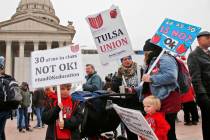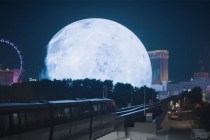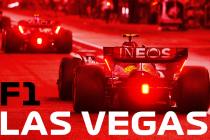Driverless cars tested in Nevada
In July of this year, Nevada Gov. Brian Sandoval enjoyed a pioneering automotive experience. He walked across the parking lot of the Department of Motor Vehicles offices in Carson City, opened the driver's side door of a Toyota Prius hybrid and slid behind the steering wheel of the car. However, during the next 10 miles of his road trip through Washoe Valley, the Toyota Prius did most of the steering and driving by itself!
Google Inc. is well-known for its Internet search engine and Android wireless mobile communication technologies. But the company also has many ongoing research projects that cover a diverse range of study. One of these is an autonomous vehicle project, led by Sebastian Thrun.
In March, Assembly Bill 511 was introduced to the Nevada Assembly Committee on Transportation. Section 8 of AB 511 proposed an amendment to existing Nevada regulatory statutes that govern the type of vehicles allowed on highways to also include "autonomous vehicles." An autonomous vehicle was defined in the bill as "a motor vehicle that uses artificial intelligence, sensors and global positioning system to drive itself without the intervention of a human operator."
AB 511 passed through the Assembly Ways and Means Committee as well as the Senate Finance Committee, where it was amended twice before being voted for final passage by both state houses. Gov. Sandoval signed the bill into law on June 16, and Nevada became the first state in the nation to allow driverless vehicles onto designated roadways.
Google's choice of Nevada as a pioneering test site for its autonomous vehicle project as well as sponsorship of the "autonomous vehicle" section of the AB 511 has a favorable history.
During October 2005, a crowd of onlookers gathered at Buffalo Bill's Resort & Casino in the state border town of Primm. SCORE International, an off-road racing organization that sponsors the annual Baja 1000, led a morning briefing to competing teams about the day's racing event. Sebastian Thrun, associate professor of computer science, and his team of engineering students from Stanford University listened attentively.
SCORE organizers had established a 132-mile, off-road course that traversed a variety of terrain over the Mojave Desert, including open dirt roads, hill climbs, rock formations, freeway underpasses and an infamous mountain gap named Beer Bottle Pass. Beer Bottle Pass was the final and toughest obstacle of the course because its dirt road included winding turns with sheer drops of 100 feet on one side and a mountain cliff wall on the other, as it wound back and forth down the mountainside.
As with most timed desert racing events, each competing vehicle was launched from the starting line after a 10-minute interval while fans of each team cheered from the bleachers. The only difference in this race -- none of the vehicles had a driver. Instead, lots of antennas, sensors and instruments provided streams of data to onboard computer systems that then processed the information into road driving actions. The computer signals alone turned steering wheels while manipulating the throttle pedal and brakes of each vehicle.
During the previous decade, the Defense Advanced Research Projects Agency, or DARPA, had been trying to find a way to mitigate human casualties from military convoys in Iraq and Afghanistan that were being sabotaged by makeshift roadside bombs and rocket-propelled grenades. In 2003, DARPA proposed a seven-year challenge to government, business and academic research communities. The "best and brightest" would race their autonomous robot vehicles against each other to prove their designs would work in the real world. The road race would have a time limit of 12 hours to complete the course and each qualifying vehicle should average at least 20 mph during the entire race. The winner would take home a $2 million prize.
At the beginning of the 2005 DARPA Grand Challenge, the teams were given a "route definition data file" that contained a series of GPS data waypoints. This digital map enabled the autonomous vehicles to use satellites to find their way along each portion of the course, similar to the way a rally car driver follows a cross-country road race map.
To "see" roadside obstacles and employ intelligent programming to maneuver around them, the vehicles could use any type of sensor recognition systems that their design teams could conceive, including ultrasonic ranging, 3D stereoscopic cameras, radar, laser-based LIDAR, gyroscopes, inertial sensors, bump sensors and more. The real challenge to the design teams, however, was how to process all this raw sensor data into intelligent decision-making by the autonomous vehicle.
During the 2005 DARPA Grand Challenge, the Stanford team's modified Volkswagen Touareg just beat out two competing GM Humvees built by students and teachers from Carnegie Mellon University. Their total time for the 132-mile route was 6 hours and 54 minutes. The two CMU Humvees came in second and third at just over 7 hours. Tulane University finished fourth with a modified Ford Escape Hybrid sports utility vehicle in 7 hours and 30 minutes.
In November 2007, the Stanford University team and Carnegie Mellon University teams met again to compete against other race teams in the DARPA Urban Grand Challenge at Victorville, Calif. This time, the event refocused system designers and computer programmers to enable their vehicles to cope with urban traffic, stop signs, oncoming vehicles, pedestrians and intersections. During the competition, the Stanford University team finished second to the Carnegie Mellon University team, followed by Virginia Tech in third place.
After two successful finishes and $3 million in DARPA award money, Thrun later joined Google Inc. to lead its autonomous vehicle research project. However, one recent setback to the program made the rounds of the media in August of this year.
After more than 150,000 miles of autonomous driving on California and Nevada roadways by the Google autonomous fleet, one self-guided Toyota Prius rear-ended another car during urban traffic in Mountain View, Calif. Though a minor fender-bender and a human behind the wheel of one car, the accident showed that Murphy's Law still applies to robot cars, as well as to human drivers: "Whatever can go wrong, will go wrong!"
Implementing more self-guided robotic technologies into automotive platforms will not end automobile accidents or manufacturer recalls. However, proponents of autonomous vehicles feel that relinquishing some driver control to intelligent sensors and safety systems could diminish fatal automotive accidents by over 50 percent. That could save thousands of lives each year.
To view archived documents from the DARPA 2005 and 2007 Grand Challenges, visit the DARPA website at: http://archive.darpa.mil/grandchallenge05/whats_new.html.
Stan Hanel has worked in the electronics industry for more than 30 years and is a long-time member of the Electric Auto Association and the Las Vegas Electric Vehicle Association. Hanel writes and edits for EAA's "Current Events" and LVEVA's "Watts Happening" newsletters. Contact him at stanhanel@aol.com.













